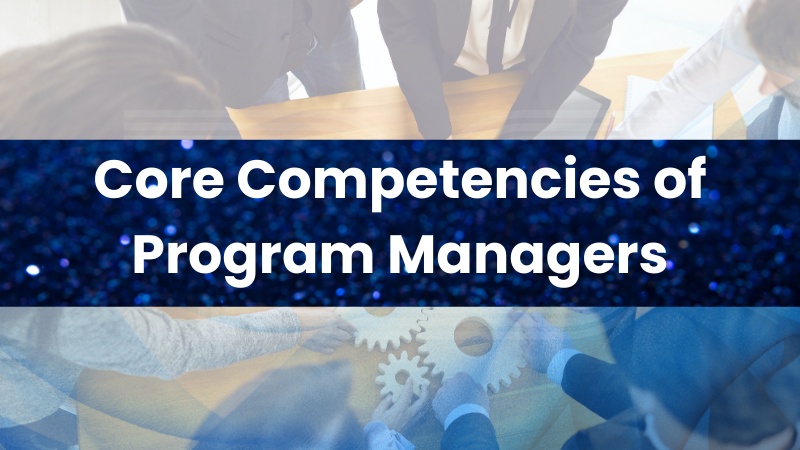
by DharamCW | Jan 22, 2025 | Program Management
Top 10 Core Competencies of Program Managers | Skills for Success | Dharam Singh & vCare Project Management
There are many similarities between a good program manager and a good project manager. However, a program manager must have broader organizational knowledge than a project manager. In addition, programs frequently necessitate strategic visioning and planning skills to align overall program goals and benefits with the organization’s long-term goals.
Here are the top ten core competencies of Program Managers:
1. Leadership and Teamwork
2. Planning and Organizing
3. Communication
4. Ethics and Ethical Values:
5. Internal and External Stakeholder Engagement
6. Political Understanding
7. Knowledge management
8. Financial Management
9. Risk management
10. Project and Process Management
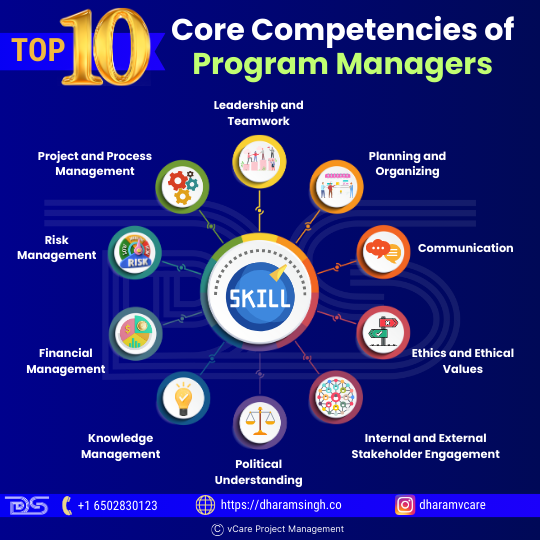
What makes a great program manager? Explore the top 10 core competencies essential for program success with insights from Dharam Singh & vCare Project Management!
🚀 Looking to deepen your knowledge? Check out our upcoming webinars featuring global experts,
1. Innovative Project Management Practices featuring Olajumoke Akinwunmi – https://bit.ly/3ZxZOx4
2. PMO Digital Transformation Leadership: Insights and Success featuring Sherwyn Cambridge – https://bit.ly/4iMvyWE
3. Culture, People, Programs, Risks: Leadership Redefined featuring Lucie Ellis – https://bit.ly/3VXv4mW
4. Resilient Leadership in Cyber-Driven Programs: Strategies from a Transformation Expert featuring Dr. Maria Sette – https://bit.ly/4j9fmPA
– Book an obligation-free consultation session on Project management Career, training, and certifications: http://talktodharam.com
– Discover training offers and certification discounts: https://bit.ly/3jWVepD
– Stay updated with our Q&A series and certification success stories by subscribing to the vCare Project Management YouTube channel at https://bit.ly/2YF0wJl
– Follow my podcasts and interviews with Project Management Experts on YouTube at https://bit.ly/2NDY8wd
#ProgramManagement #ProgramManager #ProjectManager #ProjectManagement #StrategicPlanning #StakeholderEngagement #CommunicationSkills #EthicsInLeadership #RiskManagement #FinancialManagement #Leadership #Teamwork #KnowledgeManagement #OrganizationalGrowth #ProgramLeadership #PgMP #PfMP #PMP #ProcessManagement #BusinessStrategy #ProgramSuccess #PoliticalAwareness #ManagerialSkills #AskDharam #DharamSingh #DharamSinghPgMP #DharamSinghPfMP #DharamSinghPMP #vCareProjectManagement
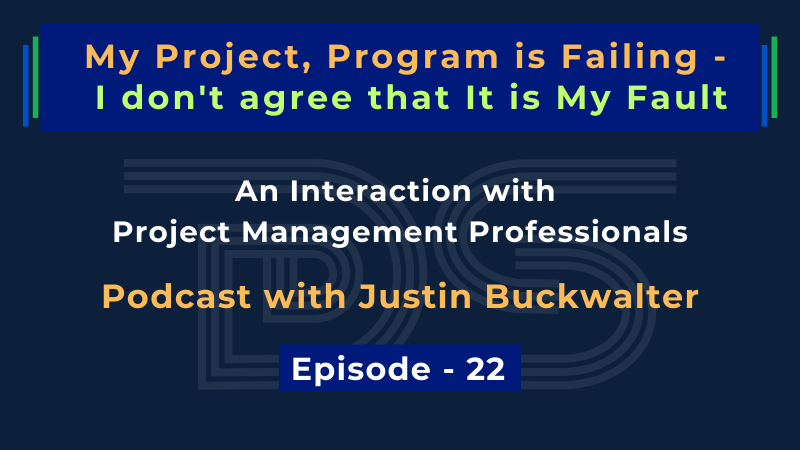
by DharamCW | Jan 15, 2025 | Project Management, Risk Management
My Project, Program is Failing – I don’t agree that It is My Fault | Justin Buckwalter | Episode 22
The following topics have been discussed in brief:
– How have emerging project management methodologies adapted to address common causes of project failure, and what lessons can be learned from past methodologies shortcomings?
– How can project managers foster a culture of resilience within their teams to better withstand setbacks and navigate the complexities of modern project environments?
– How does adopting a systemic view of failure promote project and program management transparency, collaboration, and resilience?
– Could you elaborate on how emotional intelligence among project and program managers plays a critical role in navigating the complexities of team dynamics and stakeholder management?
– With the rise of remote and globally distributed teams, what are the unique challenges in project and program management, and how can managers effectively address these issues to avoid project failure?
– Can you discuss the importance of data analytics in identifying potential project failures early and how project managers can leverage technology to make more informed decisions?
– How are sustainability and ethical considerations increasingly influencing project and program management decisions, and how do these factors impact project success rates?
– How can project and program managers enhance collaboration among cross-functional teams to mitigate the risk of project failure, particularly in complex and multi-disciplinary projects?
– Looking ahead, what emerging trends or technologies do you believe will significantly reduce project failure rates and improve overall project success?
🎥 Watch now: https://www.youtube.com/watch?v=q2H7EAFy7RE
🚀 Elevate Your Project Management Career:
– Register for my upcoming PMI Certification Success Story Webinars:
1. Innovative Project Management Practices featuring Olajumoke Akinwunmi – https://bit.ly/3ZxZOx4
2. PMO Digital Transformation Leadership: Insights and Success featuring Sherwyn Cambridge – https://bit.ly/4iMvyWE
3. Culture, People, Programs, Risks: Leadership Redefined featuring Lucie Ellis – https://bit.ly/3VXv4mW
– Book an obligation-free consultation session on Project management Career, training, and certifications: http://talktodharam.com
– Discover training offers and certification discounts: https://bit.ly/3jWVepD
– Stay updated with our Q&A series and certification success stories by subscribing to the vCare Project Management YouTube channel at https://bit.ly/2YF0wJl
– Follow my podcasts and interviews with Project Management Experts on YouTube at https://bit.ly/2NDY8wd
#ProjectManagement #ProgramManagement #ProjectFailure #EmergingMethodologies #TeamDynamics #RemoteTeams #DataAnalytics #ProjectSuccess #TechnologyInPM #PMTrends #GlobalTeams #InnovationInPM #PgMP #PfMP #PMP #PMI #AskDharam #DharamSingh #DharamSinghPgMP #DharamSinghPfMP #DharamSinghPMP #vCareProjectManagement
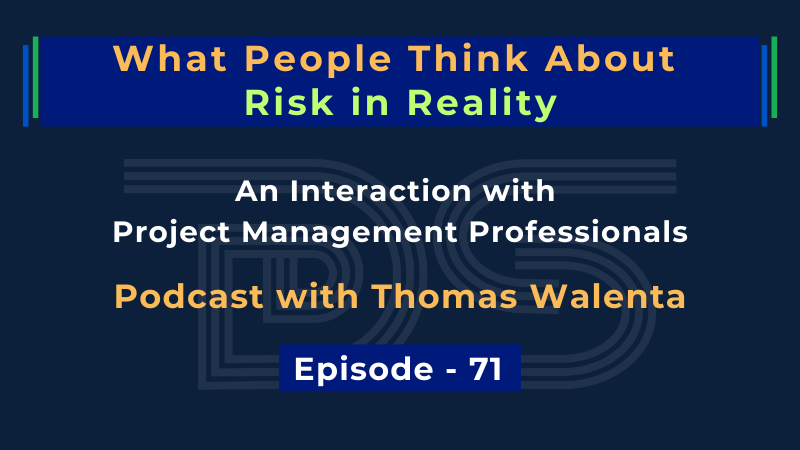
by DharamCW | Jan 9, 2025 | Risk Management
What People Think About Risk in Reality | Thomas Walenta | Dharam | Episode 71 | Project Management
The following topics have been discussed in brief:
– What People Think About Risk in Reality?
– Considering the rapid advancements in AI and machine learning, can you predict how these technologies might reshape risk management practices over the next five years? What specific changes do you foresee in project and program management as a result?
– Can you share a case where an unconventional risk management approach significantly altered a project’s outcome?
– How do quantitative metrics influence the decision-making process in risk management, and what key performance indicators do you find most valuable?
– In your experience, how have successful organizations transformed their perception of risk from a threat to an opportunity? Can you discuss specific decision-making changes this shift has brought about in risk management practices?
– Could you elaborate on the challenges and real-world consequences of adopting a reactive approach to risk management in project settings? How have you seen this approach impact project timelines and outcomes directly?
– How can organizations foster a proactive risk management culture to empower project professionals to effectively identify, assess, and mitigate risks, ultimately improving project outcomes and minimizing disruptions?
🎥 Watch now: https://www.youtube.com/watch?v=PKz3Twfjj5
🚀 Elevate Your Project Management Career:
– Book an obligation-free consultation session on Project management Career, training, and certifications: http://talktodharam.com
– Discover training offers and certification discounts: https://bit.ly/3jWVepD
– Stay updated with our Q&A series and certification success stories by subscribing to the vCare Project Management YouTube channel at https://bit.ly/2YF0wJl
– Follow my podcasts and interviews with Project Management Experts on YouTube at https://bit.ly/2NDY8wd
#RiskManagement #ProjectManagement #AIinProjectManagement #MachineLearning #RiskAssessment #ProactiveRiskManagement #QuantitativeRiskMetrics #DecisionMaking #RiskMitigation #ProjectOutcomes #OpportunityInRisk #LeadershipInRisk #RiskCulture #AIImpactOnProjects #ProjectSuccess #ProgramManagement #RiskInReality #PgMP #PfMP #PMP #PMI #AskDharam #DharamSingh #DharamSinghPgMP #DharamSinghPfMP #DharamSinghPMP #vCareProjectManagement
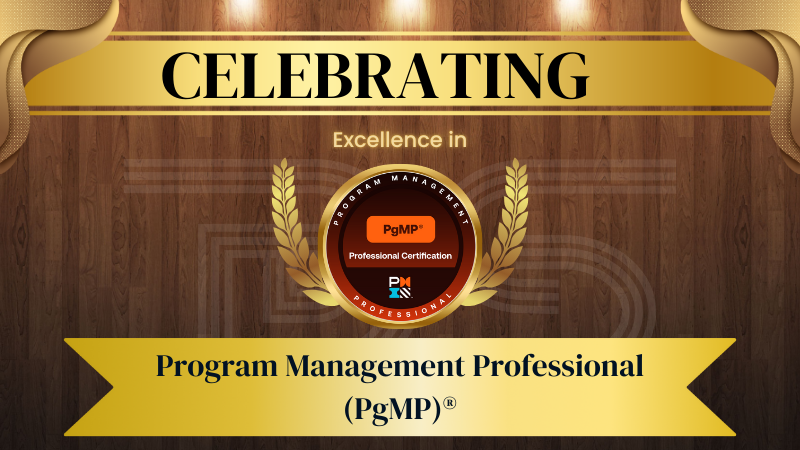
by DharamCW | Jan 4, 2025 | PMI Certification Success Stories
🎉 Celebrating Success: vCare Project Management PgMP Achievements (Oct-Dec 2024) 🌟
Congratulations to all the professionals who achieved their PgMP® certification from October to December 2024 with the support of vCare Project Management training and services! We are proud to share that we have been an integral part of the success stories of 529 professionals from 59 countries to their PgMP® certification since our inception.

vCare PgMP Certification Achievements | Oct-Dec 2024 Success Stories | Dharam Singh & vCare Project Management
This accomplishment highlights the effectiveness of our dedicated training and support services, and we couldn’t be more thrilled to have played a role in your journey. We are eager to continue supporting your professional growth and helping you achieve even greater milestones in the future.
Are you ready to take the next step in your career and elevate your program management skills? Whether you’re just starting your PgMP journey or looking to refine your skills, we’re here to guide you. DM me for personalized advice and guidance on your PgMP certification journey. Let’s make the next chapter of your professional growth a success!
View our upcoming PgMP Programs
Online – http://bit.ly/2oBKQXQ
Direct – http://bit.ly/2oCfpg0
Join our PgMP4U LinkedIn Group for the latest updates – http://bit.ly/2SBPwIp
Explore our useful PgMP Study Materials:
Complete Reference Guide for PgMP Certification | 6th Edition – https://bit.ly/3gsEkKj
PgMP Pathfinder | PgMP Mind Maps based Examination Content Outline – https://bit.ly/3pLkazn
The Standard for Program Management | Fifth Edition – https://bit.ly/43lqq4I
PgMP Challenger Gold (Mock Exams 1 to 5) | Exam Simulator – https://bit.ly/3NGrysU
PgMP Challenger Silver (Mock Exams 1 to 3) | Exam Simulator – https://bit.ly/44rOIKY
PgMP Challenger Mock Exam 1 | Exam Simulator – https://bit.ly/2RMmMAk
PgMP Challenger Mock Exam 2 | Exam Simulator – https://bit.ly/3Urs7JA
PgMP Challenger Mock Exam 3 | Exam Simulator – https://bit.ly/3JM9afX
For more insights into program management certification, training, and career development, book a personalized, obligation-free consultation session using http://talktodharam.com
Looking to deepen your knowledge? Check out our upcoming webinars featuring global experts,
1. Mastering Program Quality featuring Panagiotis Gemenetzis – https://bit.ly/3OiQAy5
2. Innovative Project Management Practices featuring Olajumoke Akinwunmi – https://bit.ly/3ZxZOx4
3. PMO Digital Transformation Leadership: Insights and Success featuring Sherwyn Cambridge PgMP®, PMP®, MBA® – https://bit.ly/4iMvyWE
4. Culture, People, Programs, Risks: Leadership Redefined featuring Lucie Ellis, SHRM-SCP, PgMP, RMP, Prosci, PMP, A-CSM, MS – https://bit.ly/3VXv4mW
#PgMP #ProgramManagement #PgMPCertification #vCarePgMP #PgMPSuccess #UnitedStates #USA #Canada #Spain #UnitedKingdom #TrinidadAndTobago #India #PMIPgMP #PgMPExam #PgMPCourse #PgMPTraining #PgMPPreparation #PgMPGuide #PgMPPrep #PgMPOnlineTraining #PgMPBootcamp #AskDharam #DharamSingh #DharamSinghPgMP #vCareProjectManagement
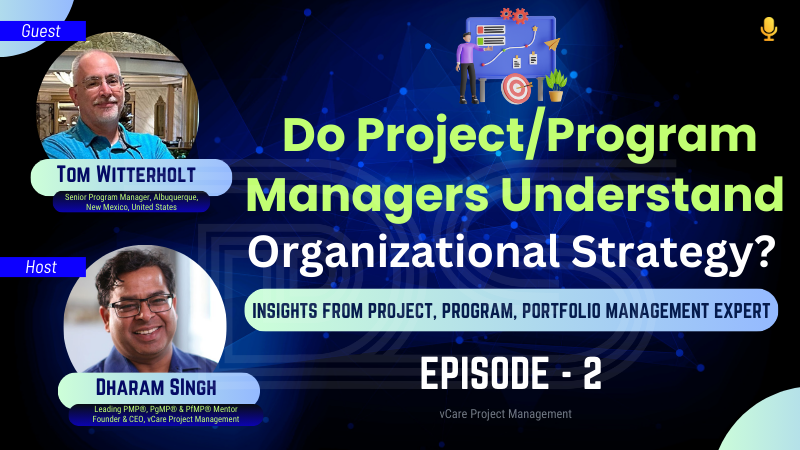
by DharamCW | Dec 13, 2024 | Podcast, Project-Program-Portfolio Management Knowledge











Do Project/Program Managers Understand Organizational Strategy? | Tom Witterholt | Dharam Singh | PMI PgMP | Episode 2
Do you think today’s project/program managers understand the organizational strategy as they should be?
– Understanding Organizational Strategy
– What is strategy?
– Do today’s managers fully grasp organizational strategy?
– Don’t be obnoxious! – Project/Program Managers